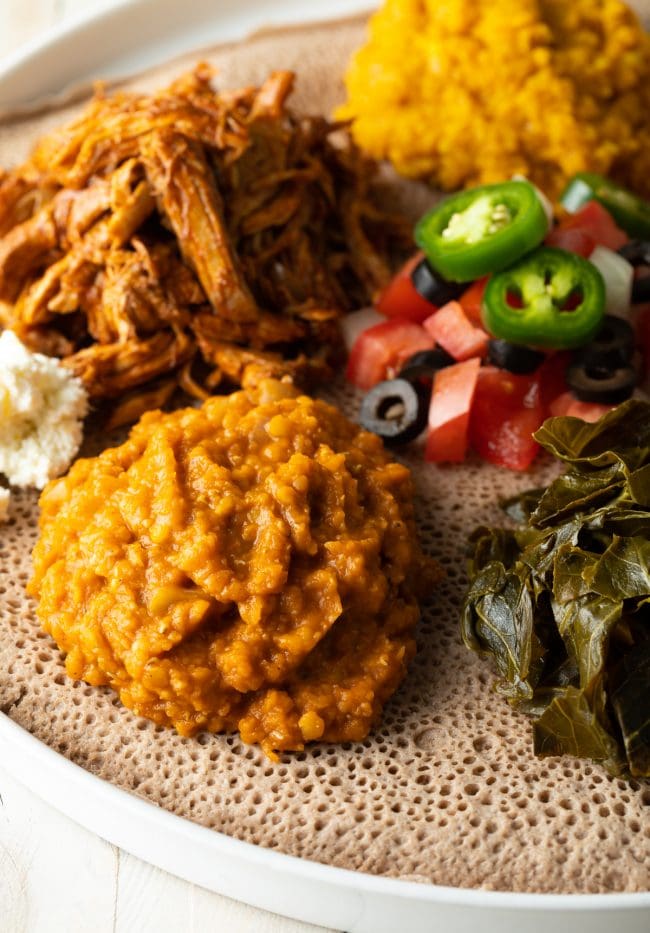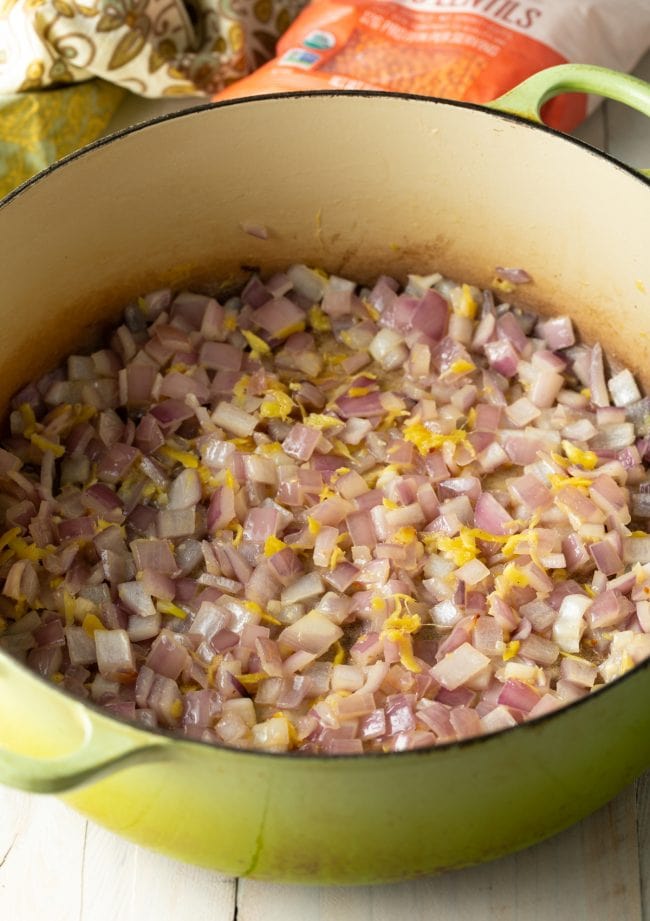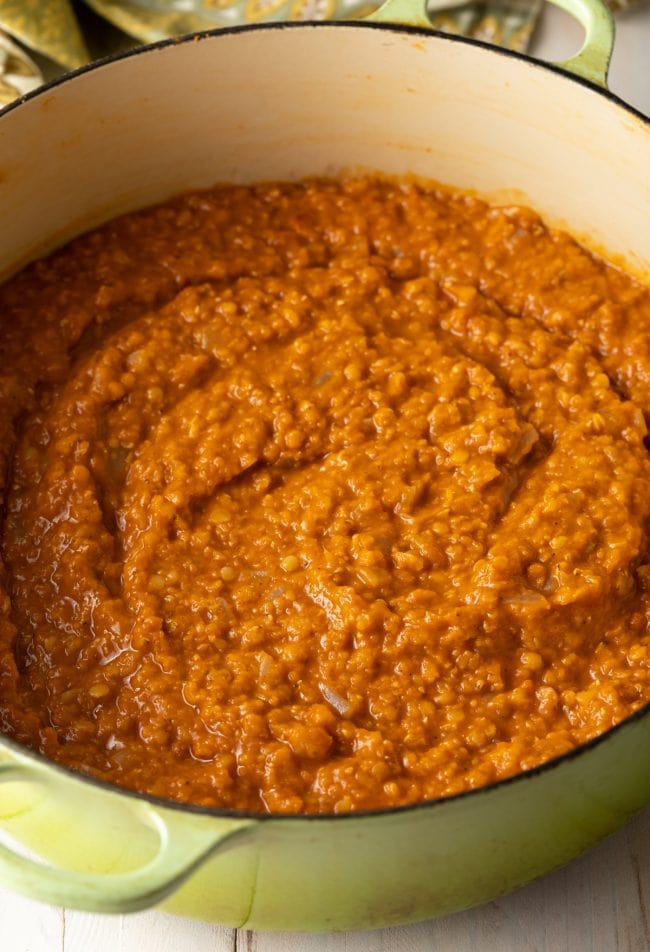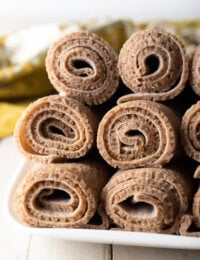Ethiopian Recipes
Classic Ethiopian Recipes are a celebration of exotic spices and slow-cooked flavor. Misir Wot (or Mesir Wat), a traditional Red Lentil Stew, is both bold and comforting, with a generous dollop of creamy Ayib cheese on top.


Sommer’s Recipe Notes
These Ethiopian recipes capture the heart of Ethiopian cuisine —bold, complex flavors that transform simple ingredients into something extraordinary. The way spices like garlic, ginger, and berbere blend together in Misir Wot creates a rich, aromatic experience that dances on the palate.
What makes this Ethiopian Lentil Stew even more special is its versatility. While berbere paste is the traditional go-to, our substitute blend of Garam Masala, paprika, turmeric, and tomato paste allows us to recreate that authentic flavor with what we have on hand.
And let’s not forget the topping—Ayib. This soft, crumbly Ethiopian cheese acts as the perfect contrast to the stew, mellowing the heat and adding a delightful creamy texture that rounds out the dish.
Why You’ll Love These Ethiopian Recipes
- Exciting comfort food – This dish is both comforting and exciting, with layers of heat and warmth that aren’t just spicy but deeply flavorful. It’s one of my favorite Ethiopian dishes!
- Perfect balance of spices – Misir Wot has the perfect balance of rich and deep spices, and just the right amount of heat, making it accessible for anyone to enjoy.
- Texture bliss – The creamy nature of the stew and the crumbly, refreshing cheese make for the most delicious bite of textures in every spoonful.
This combination of spices, textures, and flavors is why we can’t get enough of Misir Wot. It’s not just a meal; it’s an experience.

Ingredients and Tips
- Dry red lentils – Quick-cooking red lentils are ideal, but you can also use yellow lentils or split peas as a substitute.
- Onion – Use a large, chopped onion.
- Butter – Unsalted butter gives a rich flavor, but you can swap it for ghee, olive oil, or coconut oil for a dairy-free version.
- Fresh grated ginger – Fresh ginger will give it the best flavor, but ground ginger can be used in a pinch.
- Ethiopian spice mix – This is a blend of hot smoked paprika, turmeric and garam masala.
- Tomato paste – If you prefer, you can also use tomato sauce or crushed tomatoes.
- Cottage cheese – For the ayib, I prefer to use cottage cheese.
- Lemon zest – For best results, use fresh lemon zest.
- Plain Greek yogurt – Use full-fat or skim Greek yogurt.
Recipe Variations and Dietary Swaps
- Berbere Paste or Spice Blend – If you happen to have Berbere paste on hand, you can use 3 1/2 tablespoons in place of the paprika, turmeric, garam masala, and tomato paste. If you have Berbere Spice Blend, do not omit the tomato paste, but swap 5 teaspoons for the paprika, turmeric, garam masala.
- Other cheese – If you don’t have cottage cheese, ricotta, paneer, or labneh can also be used.
- Sour cream – Swap the Greek yogurt with sour cream for an even creamier and thicker version of this lentil stew.
- Vegan – Use a dairy-free yogurt, olive oil instead of butter and make the Ayib with a plant-based cheese.
- Leafy greens – Stir in leafy greens like kale, collard greens or spinach. You can even add shredded cabbage.
- Sausage – Stir in finely crumbled sausage for extra protein and flavor.
- Extra spicy – Mix in a pinch of cayenne pepper for extra heat.

How to Make Traditional Red Lentil Stew
Making these Ethiopian recipes at home is a lot easier than you might imagine, and in less than an hour you’ll have the most comforting and delicious lentil stew! Every bite is a layer of incredible flavors and spices, and it all comes together in a few, easy-to-follow steps.
Find the full Ethiopian Lentil Stew Recipe with detailed instructions and storage tips in the printable form at the bottom of the post!




Storage Notes
- Storing Leftovers – Store leftover lentils in an airtight container for up to 5 days. Ayib can also be stored in the refrigerator in an airtight container for up to 3 days, but it’s best eaten fresh.
- Freezing Leftovers – You can place lentils in a freezer-safe container and freeze for up to 3 months.
- Reheating Leftovers – Reheat lentils in a saucepan over medium heat or in the microwave in short bursts, making sure to stir frequently.
Serving Suggestions
You can enjoy rich, zesty Misir Wot with Ayib on top, all by itself. Yet if you want to experience a full Ethiopian food family experience, serve it with some other delicious Ethiopian recipes. My favorites include:

Ethiopian Lentils Recipe (Misir Wot Recipe with Ayib)
Ingredients
For the Misir Wot Red Lentil Stew:
- 2 cups red lentils
- 1 large onion chopped
- 3 tablespoons butter
- 2 tablespoons fresh grated ginger
- 2 cloves garlic minced
- 1 tablespoon hot smoked paprika
- 1 teaspoon tumeric
- 1 teaspoon garam masala
- 2 tablespoons tomato paste
- Salt and pepper
For the Ayib (Iab):
- 3 cups small curd cottage cheese
- Zest of 1 lemon
- 3 tablespoons plain Greek yogurt
- 1/4 teaspoon salt
Instructions
For the Misir Wot:
- Place a large sauce pot over medium heat. Add the butter and chopped onions and saute for 3-5 minutes, until soft. Add the ginger and garlic and saute another 2 minutes.
- Next add the spices and tomato paste along with 2 teaspoons of salt. Mix well, then add the lentils and 6 cups of water.
- Cover the pot and bring to a boil. Once boiling, lower the heat and simmer for 20 minutes.
- Uncover and stir the lentils, then continue to cook uncovered for another 10-15 minutes until a thick porridge-like consistency is reached. Remove from heat and cover until ready to serve.
For the Ayib:
- Rinse and drain the cottage cheese in cold water until only clean curds are left. Place the curds in a bowl and press them dry with paper towels until most of the moisture in removed and the curds have broken up.
- Mix in the yogurt, lemon zest and salt. Refrigerated until ready to serve. To serve: Scoop the Mesir Wat into bowl and place a generous dollop of Ayib on top.
Notes
Nutrition

Frequently Asked Questions
I used dried lentils in this recipe. They do not need to be soaked before adding them to this recipe.
Brown/Green Lentils would be fine. However, red lentils may be easier to find than you think. (I found them in the bulk-bins at my small town grocery store.) Just note that various types of lentils require different cooking times. Check the package cooking instructions and adjust the recipe as needed.







MMMMMMMMMMM!!!!!!!! This is so delicious. I’ve chanced upon your pages by accident, but what a treat! I love lentils and we have them a few times every month. They are great to mix with so may ingredients. I often invent new lentils recipes by myself. But this tops all I know about lentils.
Thank you!!